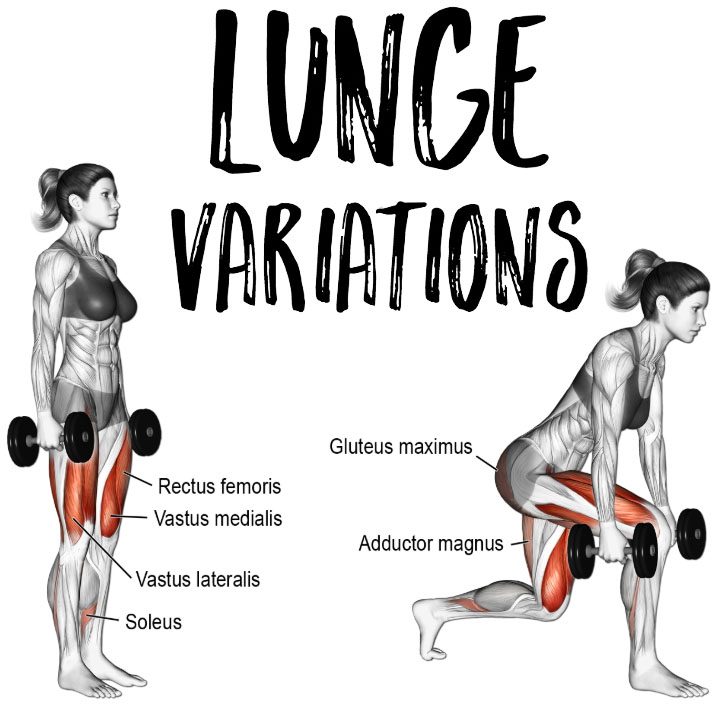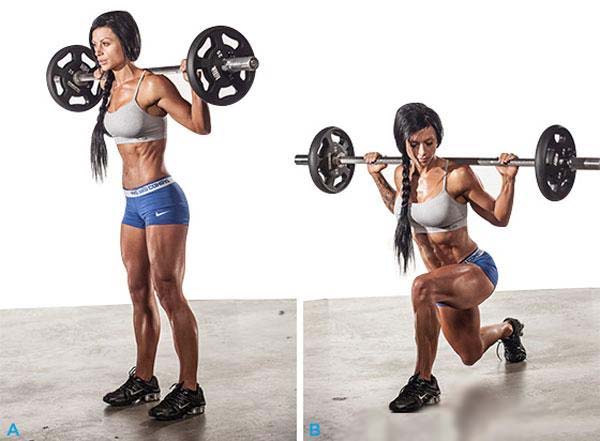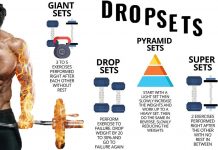🔥 Barbell back lunges

[wp_ad_camp_1]
Reverse lunges with a barbell – an exercise similar to direct lunges with a barbell, except that the movement is performed backward, and not forward. Exercise is convenient to perform on the spot, doing lunges with legs alternately. As with direct lunges, back lunges with a barbell are mainly aimed at working out the muscles of the quadriceps of the thigh, additional load is placed on the muscles of the back of the thigh, buttocks and muscles of the leg.
Back lunges or sometimes also called lunges back are aimed at high-quality pumping of the muscles of the front of the thigh and gluteal muscles. The exercise is allowed to be performed with such shells as dumbbells, barbell, as well as with your own body weight without the use of additional weights.
Exercise is used both to develop strength and mass of the muscles of the legs, as well as to hone the relief of the shape of the legs and buttocks.
Level of difficulty: recommended for both experienced athletes and beginners;
[wp_ad_camp_2]
Loaded muscles
Reverse lunges load the following muscles:
- quadriceps (muscles of the anterior surface of the thigh) – actively participate in lunges;
- gluteal muscles (gluteus maximus), adductors also perform the main load;
- the back surface of the thigh (biceps of the thigh), on which additional burden falls;
- calf muscles perform the function of stabilizing the position of the body;
- muscles of the cortex (muscles of the abdomen and extensors of the spine), work in a static mode as muscles of stabilizers.
The exercise requires well-developed flexibility, as well as the ability to maintain balance. Therefore, novice athletes may need some time to master back lunges, but after a few workouts, he will be able to easily maintain a stable body position.
Back lunges with a barbell create a large load on the spine, as well as on the knee joint of the working leg, as a result of which the exercise requires strict adherence to the correct technique. Exercise is not recommended for people with problems with the back or knees.
Thus, for beginners, it is advisable to initially work out with their own body weight or to take small dumbbells in each hand to balance their motor skill.
[wp_ad_camp_3]
To complete the exercise, you will need the following equipment:
Straight barbell
Technique for performing back lunges with a barbell:
- Place a weight bar on the upper back (on the trapezius muscles just below the neck) and hold it with your raised hands in the neck with a wide grip, controlling its position. In addition, you can start the exercise using racks or a power frame to make it easier to take up the starting position. Stand straight, take your shoulders back, while maintaining a natural bend in the back, the knees do not close. Your legs should be shoulder width apart. This is your starting position.
- Maintaining a straight position, initiate movement by stepping back one foot approximately 2 feet (60 cm), keeping your hips facing forward, with the toe touching the floor first with your back foot. Then both knees should bend, lowering the body below and allowing the knee of the leg, which makes a lunge, to touch the floor.
- Your body should remain upright. Do not lean forward or bend your back. Climb up, straightening the hind leg and maintaining balance, and return to the starting position.
- Repeat on the other side, and repeat for the required number of repetitions.
Implementation Tips:
- This is a movement that requires good balance, so if you have problems maintaining body balance, you can either avoid it or just use your own body weight during the exercise. Definitely never lunge with a barbell on your back if you have balance problems.
- A step back is made wide enough so that each leg is bent at a right angle. The forefoot should not extend beyond the knee.
- During the approach, your back should be straight, do not lean forward and do not round it, otherwise the effectiveness of the exercise will deteriorate and the risk of injury will increase;
- To shift the emphasis of the load on the quadriceps, keep right angles in the knee joints of the front and supporting legs. While climbing up, feel the quadriceps contract, resting against the floor with the entire surface of the foot;
[wp_ad_camp_5]
Execution Lunges Options:
- A more complicated version of the exercise is walking lunge, in which you walk around the gym and doing lunging. For lunge walks, the hind leg left behind is pushed forward after the lunge with the front foot is fully completed. This lunging option is for experienced athletes.
- Exercise with a barbell can also be replace in the Smith simulator. In this case, this will allow you to lift a more significant weight, without fear of losing balance. However, it is worth noting that very heavy weights in lunges are not used.



















































